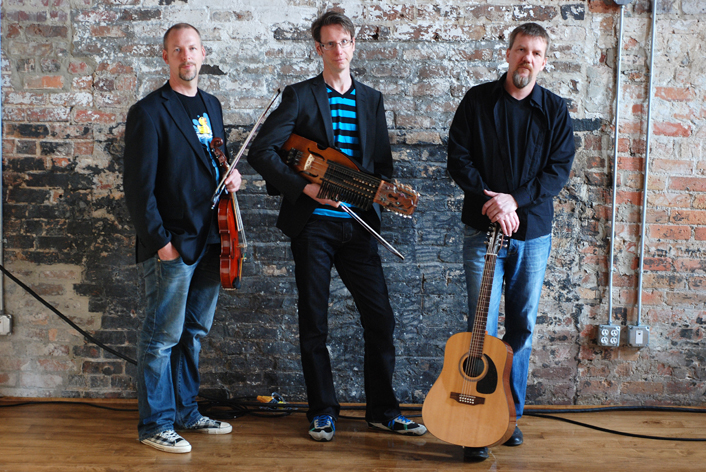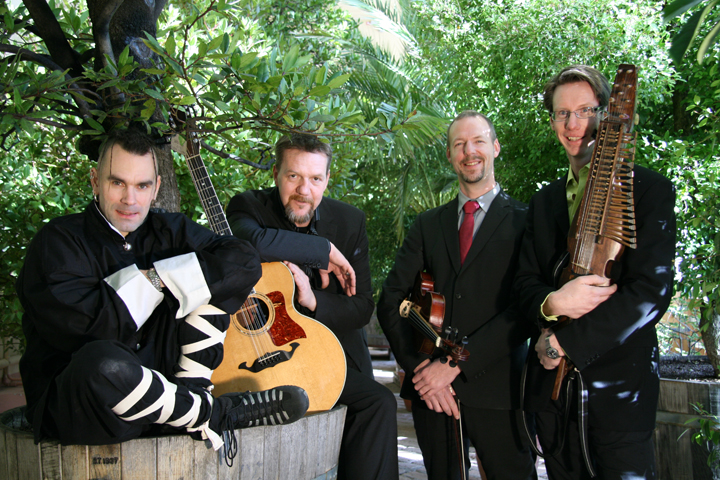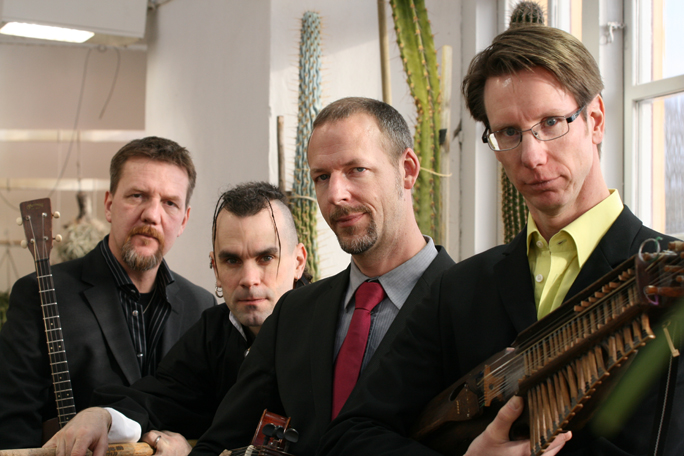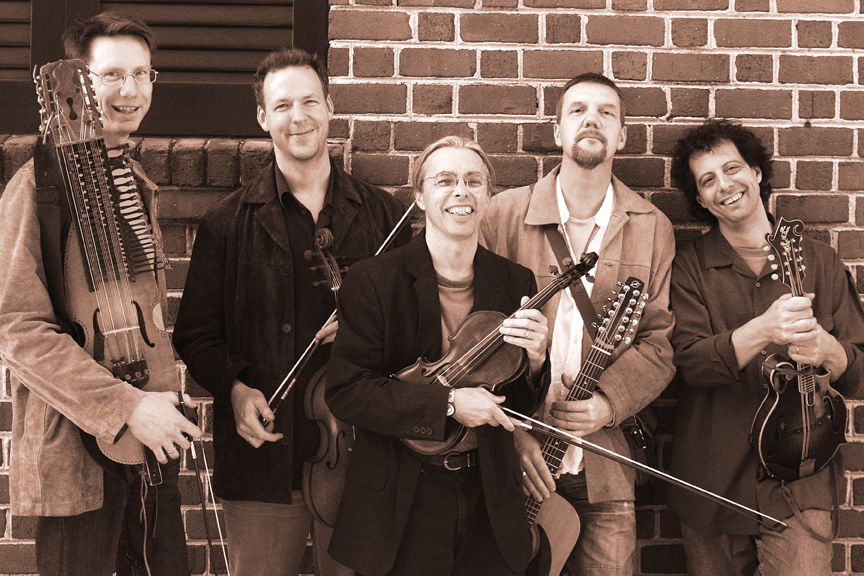20 years later, Väsen’s ‘essence’ still sounds strong.
The Golden Toad Music and Dance Camp—a 5 day music retreat in San Pablo, CA—will be featuring Väsen at this summer’s camp in June. Väsen, the Scandinavian acoustic powerhouse, is celebrating two decades of making music worldwide and building musical bridges across the world.
-
 Väsen Trio. Photo: Maria Camillo
Väsen Trio. Photo: Maria Camillo -
-
Albuquerque, New Mexico-based writer Neal Anderson met up with Väsen for Nordstjernan during their recent U.S. tour.
-
 Väsen Quartet. Photo: Mia Gustafsson
Väsen Quartet. Photo: Mia Gustafsson -
-
by Neal Anderson
-
 Väsen Quartet. Photo: Mia Gustafsson
Väsen Quartet. Photo: Mia Gustafsson -
From playing festivals in their native Sweden and North America to jamming at concert gigs in Europe and Japan, Väsen has been on a journey that has honored the spirit of traditional Swedish folk music but has made contemporary inroads and detours—most recently by collaborating with an American bluegrass duo.
The group’s 20th year of playing has been inaugurated with the release of “Väsen Street,” the musicians’ 15th album and latest entry in a long line of various recorded incarnations and collaborations. Critically acclaimed from the start, the band has not been a stranger to such praise as "Väsen treads an enchanted territory between classical, folk and pop” from the Utne Reader or from a critic in The Washington Post who wrote, "... the band's anciently original compositions can be immensely brooding, stately, fitfully spry or dramatically expansive."
About 10 days into their most recent U.S. tour, which included stops in Minnesota, California and Pennsylvania, Olov Johansson and Mikael Marin, two of Väsen’s members, took time out for a backstage interview after a warm September night performance at İGlobalquerque!, a world music and culture festival in Albuquerque, N.M.
They spoke about their 20 years together, the band’s beginnings, their dedicated fan base and their collaboration with American bluegrass players Mike Marshall and Darol Anger. The Nordic neotraditionalists had just played an indoor set as a trio, comprising nyckelharpa player Johansson, violist Marin and guitarist Roger Tallroth. They had alternated on stage with mandolin player Marshall and fiddler Anger, who played a few pieces of their own as a duo, and then the performance culminated with all five musicians playing together.
During the concert, the lanky Johansson, the most extroverted member of the group, cracked jokes, including references to his unusual looking nyckelharpa and imitating the flat American pronunciation of the name of this multistringed traditional Swedish instrument. Although the humor showed the musicians didn’t take themselves too seriously, it was the music that clearly captivated the audience.
Whether they were playing the inventive “Loke’s Troubles” from their collaboration with Marshall & Anger or the beguiling “Josefin’s Waltz,” a tune by Tallroth from the “Trio” album that has caught on in Celtic music circles, the listeners grew more enthusiastic with each piece. At the end of their set, the group’s musical craftsmanship had the audience on their feet, giving an effusive ovation. -
 Mike Marshall & Darol Anger With Väsen. Photo: Claudia Marcelloni
Mike Marshall & Darol Anger With Väsen. Photo: Claudia Marcelloni -
‘Our creation myth’
Väsen’s origins are rooted at a 1989 music gathering in Røros, Norway, in a frequently repeated tale which Johansson wryly calls, “Our creation myth, you could say, for the band.” Johansson, already considered a riksspelman (master musician) of the nyckelharpa, had been playing with viola player Marin for a while, but he met Roger Tallroth at the festival and asked if he would like to jam.
“Mikael and I knew each other and had played a lot together. Roger was there (at the music festival) playing on a 12-string guitar. I thought that it would go really well with the nyckelharpa … but he really wanted to take a shower … so he put down the guitar, but the shower was occupied. And then he came back and started to play,” Johansson said.
Thus fate intervened in the form of a no-go shower appointment and a lengthy, late-night jam session. Eventually a trio was born and they recorded their first album and started calling themselves Väsen, which means “noise" or "spirit.”
“Every living thing has its essence or spirit—like a tree, a porcupine or a musician—but it (väsen) can also mean noise or sound,” Johansson and Marin explained.
Although rooted in the traditions of Swedish folk music and having learned from revered, older traditional musicians such as Uppland’s Curt and Ivar Tallroth and Eric Sahlström (“They were our heroes,” Johansson said), the trio wanted to go beyond the roots revival that was going on then in Swedish folk music.
“We were young and we were a new generation in our area (Uppland). We came up with something new, something fresh,” Johansson said, and it’s that philosophy of composing original music that has transformed the band’s sound over the past two decades, so that now “our music now is very much more Väsen music than traditional Swedish music.”
In the years since that fateful meeting in Norway, the members have kept busy, collaborating frequently on albums and tours, embarking on their own solo projects and teaching. They also have regularly incorporated a fourth member into the group, percussionist André Ferrari, who usually does not travel outside of Sweden with them.
Another fortuitous collaboration came after connecting with Marshall & Anger at the Lotus Festival in Bloomington, Ind., five years ago. Anger had been trying to contact the band through e-mail to explore playing together, but the eclectic, acoustic mix didn’t take hold until in-person jam sessions. They now frequently play with the duo at gigs in the U.S. and occasionally in Sweden, including Uppsala, where Tallroth and Johansson live. Marin now resides in Stockholm.
Today they play 50 to 100 concerts each year all over the world. When they return home to Sweden, they usually play smaller venues with 100 to 200 people in smaller acoustic-oriented halls where people, Johansson and Marin said, can fully appreciate their sound. “It’s chamber music really,” Johansson explained.
But it’s technological innovation that has also allowed the Swedish group and their American colleagues to collaborate. Johansson explained that when the Swedes and Americans can’t jam together in person, each of the musicians writes music and will often e-mail audio files and music to let each other know what they are working on. This kind of collaboration resulted in the 2007 album “Mike Marshall & Darol Anger with Väsen,” which reflects and blends the disparate roots of the musicians.
Technology also helps feed not only their communication with fellow musicians but their fan base, too. “We have a really devoted one,” Johansson said. By using social media like Facebook and MySpace, “It has made the world much smaller.” The band is able to better gauge its international following with orders for CDs from places like Australia, Canada and New Zealand.
As for their fans, it’s those with a taste for music such as the bluegrass and acoustic genres and fellow musicians who have appreciated the group’s talent. “We’ve captured them,” Johansson said.
“We’re gaining a new audience all the time in Sweden,” he said, adding that many of the younger fans weren’t even born when they started out but readily get into the group’s music at concerts and folk music festivals all around the country.
As for the past 20 years: “We are out on a fun adventure. We never planned our career. We just try to have a good time and make music … and things have happened, and we’ve picked up suggestions that people have made to us,” Johansson said. “After 20 years we still really have a good time.” -
More info on Väsen, see www.vasen.se
-
-
